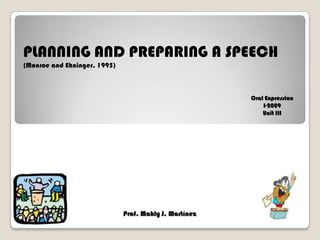
Planning Your EFL Speech
- 1. PLANNING AND PREPARING A SPEECH (Monroe and Ehninger, 1995) Oral Expression I-2009 Unit III Prof. Mahly J. Martínez
- 2. METHODS OF SPEAKING Oral Presentations and Public speeches are likely the most used activities in the EFL Classroom. This is due to the fact that speaking is one the linguistic skill to be developed in FL. There are Four types of speeches: Impromtup speech Memorized Speech Read Speech Extemporanous Speech
- 3. IMPROMTUPSPEECH It is the one delivered in the spur of the moment. It requires the least preparation; with little advanced notice, the speaker is asked to speak for a few minutes on a specific subject. The speaker relies on previous knowledge of the topic (and the language). The speaker have to limit himself to a specific aspect that can be discussed in a few minutes. The body of your speech must be unified. Examples, illustrations, comparisons, and contrasts to help explain the topic. Conclude on a strong note. Restatethembrieflybutclearly.
- 4. MEMORIZED SPEECH It is written word by word and committed to memory. Few speakers are able to use this methods effectively since its relies on memory skills. It is a speech that is read, it lacks spontaneity. In addition, memory can fail during delivery and can cause embarrassment. This type of speech should not be used in public speaking classes. Here are some guidelines in giving a memorized speech: Stay focused on your specific purpose and on the key ideas you want to convey. Practice, practice, practice
- 5. READ SPEECH A Read speech is written out and read. It is used when it’s important that the exact words are used in a correct way, a read speech is appropriate. Political leaders read speeches for accuracy and precision. It’s important for the speaker reading a speech to maintain rapport with the audience. Here are some guidelines in giving a manuscript speech: Only use a manuscript when what you are saying is of critical importance. Use good oral style. Practice, practice, practice. Develop body language and gestures that support what you are saying. Use effective vocal variety/contrast. Remain flexible.
- 6. EXTEMPORANOUS SPEECH This should be the commonly used method of speaking in EFL class. It is not read nor memorized. It is spontaneous and natural. The speaker has time to prepare the ideas they wish to convey and the actual words are formulated at the moment of delivery. This type speech must also be practiced but the words and arrangement of words are changed to something better and more effective. In rehearsing and delivering, the speaker is simply guided by an outline. The speaker doesn’t memorize the speech, but the order of ideas to achieve unity, organization, and clarity in speech. Anextemporaneousspeech: Requirescarefulpreparation. It is based on a key word outline. Allows the speaker to remain direct, involved, and flexible.
- 8. Students can improve their oral skills, specially fluency.
- 10. PREPARE OR NOT PREPARE? COMMENCEMENT SPEECH AT TULANE’S UNIVERSITY 2009 Whatkind of speakingmethoddidshe use? Wasit prepare? Whichwasellen’spurpose? Wasitappropriateforthesetting?